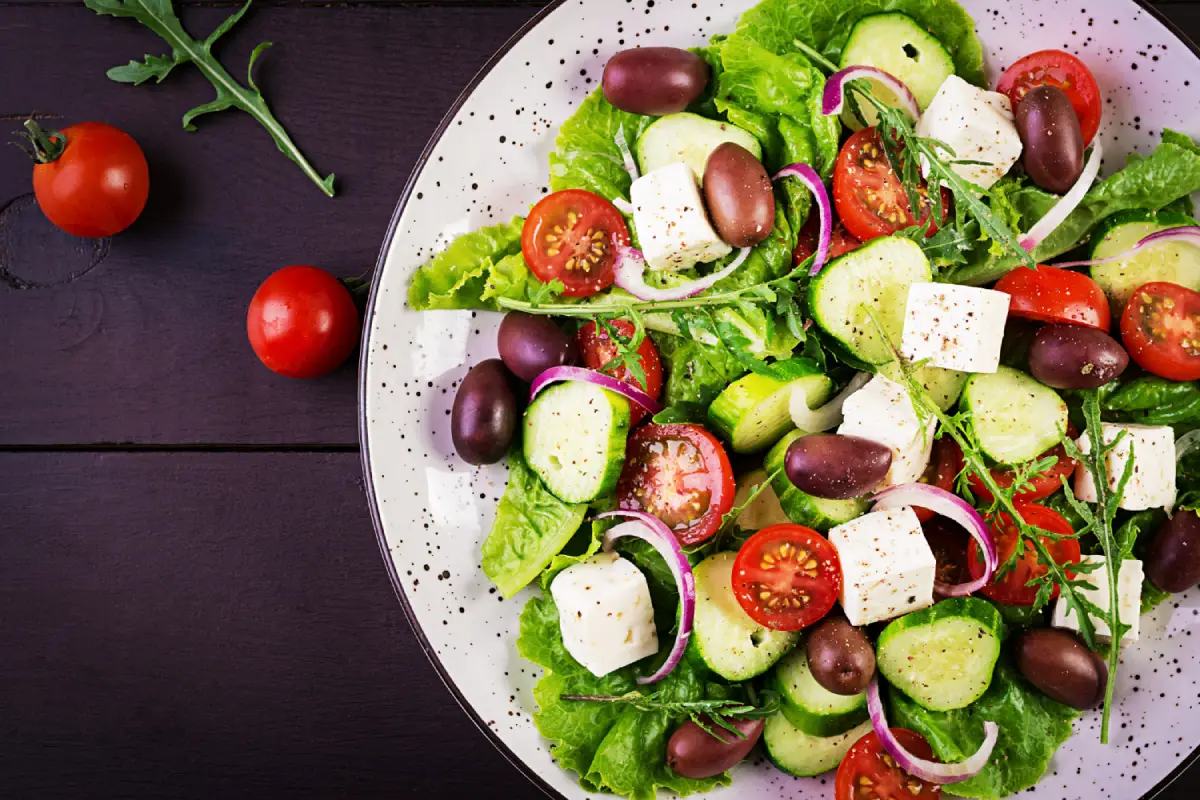Dive into the heart of Mediterranean flavors with our Ultimate Greek Salad Recipe, a celebration of freshness, simplicity, and tradition. This article is your gateway to mastering the art of crafting the perfect Greek salad, known in Greece as Horiatiki. With crisp vegetables, luscious tomatoes, creamy feta, and olives as rich as the Aegean sea, you’ll discover not just the steps to making this iconic dish, but also the stories and traditions behind it. From selecting the finest ingredients to exploring its cultural roots, prepare to elevate your culinary skills and bring a piece of Greece to your table.
History and Origin of Greek Salad
The Greek salad, or “Horiatiki,” stands as a cornerstone of Greek cuisine, embodying the simplicity and vibrancy of Mediterranean eating habits. Its foundations are deeply rooted in the ancient Greek tradition of utilizing fresh, seasonal ingredients, reflecting the country’s agricultural wealth. The version known today, adorned with ripe tomatoes, crisp cucumbers, sharp onions, briny olives, and creamy feta, all brought together with a drizzle of olive oil, evolved in the 20th century. Yet, it maintains the spirit of ancient dietary practices, showcasing the enduring importance of freshness and simplicity in Greek cooking.
This salad is more than just a combination of ingredients; it is a cultural emblem that underscores the Greek philosophy of harmonizing with nature. Emphasizing seasonal produce, the Greek salad encapsulates a lifestyle that cherishes the land’s cyclic bounty. The addition of feta cheese, a later innovation, not only enhanced its flavors but also solidified its status as a national culinary treasure, beloved for both its taste and its reflection of Greek agricultural traditions.
As the Greek diaspora spread their culinary wings across the globe, so did the popularity of the Greek salad, making it a global phenomenon. It transcended its humble origins to become a symbol of healthy, simplistic eating worldwide. This universal acceptance speaks volumes of the salad’s ability to connect people with the essence of Mediterranean life, celebrating the unpretentious beauty of its ingredients and the rich tapestry of Greek culture.

Ingredients and Step by Step
Crafting the perfect Greek Salad, or “Horiatiki,” requires a blend of fresh ingredients and simple, yet precise preparation steps. Let’s embark on the culinary journey to create this quintessential Mediterranean dish.
Ingredients:
- 4 ripe tomatoes, cut into wedges
- 1 cucumber, sliced into thick half-moons
- 1 red onion, thinly sliced
- 1 green bell pepper, sliced
- A handful of Kalamata olives
- 200g (7 oz) of feta cheese, sliced or crumbled
- Extra virgin olive oil, for dressing
- Red wine vinegar, a splash (optional)
- Sea salt and freshly ground black pepper, to taste
- Dried oregano, for garnish
Step by Step:
- Prepare the Vegetables: Begin by preparing your vegetables. Wash the tomatoes, cucumber, and green bell pepper. Cut the tomatoes into wedges, slice the cucumber into thick half-moons, and slice the green bell pepper. Peel and thinly slice the red onion. Arrange these ingredients in a large salad bowl.
- Add Olives and Feta: Scatter a handful of Kalamata olives over the top of the salad. Then, add the feta cheese. You can either slice the feta and place it on top as a single block or crumble it over the salad for a more distributed flavor.
- Season: Drizzle the salad generously with extra virgin olive oil and a splash of red wine vinegar, if using. Season with sea salt and freshly ground black pepper to taste. Remember, feta cheese and olives are salty, so add salt sparingly.
- Garnish and Serve: Finally, sprinkle dried oregano over the salad for that authentic Greek touch. Give the salad a gentle toss if you like, or serve it as is, allowing guests to mix their own portions.
- Serving Suggestion: Greek Salad is best served fresh, alongside crusty bread or as part of a larger meal featuring dishes like grilled meats or fish. For a complete Mediterranean experience, pair it with a glass of chilled white wine or ouzo.
This step-by-step guide ensures that even a novice cook can present a dish bursting with the flavors of Greece. Each bite of this Greek Salad brings a taste of the Mediterranean lifestyle right to your table, celebrating the simplicity and richness of its ingredients. Enjoy the harmony of flavors and textures that make this dish a timeless classic.
Nutritional Profile
Greek Salad, known for its vibrant ingredients, is not just a feast for the eyes but also a powerhouse of nutrition. Each component brings its own set of health benefits, making this dish a holistic choice for those looking to indulge in something delicious yet wholesome.
- Tomatoes are rich in vitamins C and K, potassium, and folate. They offer antioxidants like lycopene, which has been linked to reduced risk of heart disease and cancer.
- Cucumbers contain antioxidants and are hydrating, contributing to overall hydration and skin health.
- Red onions are excellent sources of antioxidants and flavonoids, which can lower blood pressure and reduce heart disease risk.
- Green bell peppers are loaded with vitamins A and C, supporting immune function and skin health.
- Kalamata olives and extra virgin olive oil provide healthy fats, particularly oleic acid, which has anti-inflammatory properties and supports heart health.
- Feta cheese, although higher in sodium, offers calcium for bone health and probiotics that can enhance gut health.
- Oregano adds not just flavor but also boasts antibacterial and anti-inflammatory benefits.
This salad is a low-calorie option that’s high in fiber, promoting satiety and digestive health, making it an ideal choice for weight management and overall well-being.
Perfect Pairings
To elevate your Greek Salad experience, consider pairing it with dishes that complement its freshness and tang. Here are some delightful combinations:
- Grilled Meats: Lamb, chicken, or pork, seasoned with herbs and lemon, harmonize beautifully with the freshness of the salad.
- Seafood: Grilled or baked fish, such as salmon or seabass, offers a rich, fatty contrast to the crisp, acidic elements of the salad.
- Starches: Crusty bread or pita, toasted with a bit of olive oil and garlic, makes for a simple, satisfying addition. For a heartier meal, pair with lemon-roasted potatoes.
- Wines: A crisp, dry white wine like Assyrtiko or a Rosé complements the salad’s flavors without overpowering them. For a non-alcoholic option, sparkling water with a lemon wedge is refreshing.
Customization Tips
The Greek Salad is versatile, allowing for adaptations to cater to various dietary preferences or to just spice things up. Here are some ideas:
- Vegan Version: Omit the feta cheese or substitute with vegan feta to cater to dairy-free or vegan diets.
- Protein Boost: Add grilled chicken, tofu, or chickpeas for a protein-rich meal.
- Change of Cheese: Though feta is traditional, try goat cheese or shaved Parmesan for a different taste profile.
- Additional Vegetables: Feel free to incorporate avocado for creaminess, spinach for a leafy base, or roasted red peppers for a sweet contrast.
- Dressing Variations: While olive oil and red wine vinegar are classic, experimenting with lemon juice or a balsamic reduction can offer a delightful twist.
By embracing these customization tips, you can make the Greek Salad fit any occasion, preference, or dietary requirement, ensuring it remains a beloved staple in your culinary repertoire.
Seasonal and Global Twists
Seasonal Twists
The Greek Salad’s adaptability to seasonal ingredients makes it a year-round favorite, allowing it to reflect the flavors of each season while maintaining its Mediterranean soul.
- Spring: Introduce fresh asparagus, radishes, or snap peas for a crisp, verdant twist. Spring herbs like dill or mint can add freshness and brightness.
- Summer: Incorporate ripe peaches or watermelon for a sweet contrast to the salty feta and olives. Summer is also perfect for adding fresh basil or parsley.
- Fall: Roasted butternut squash or beets can introduce a warm, earthy element, complementing the crispness of the traditional ingredients.
- Winter: Add pomegranate seeds for a burst of color and sweetness, or marinated artichoke hearts for a tangy, hearty addition.
Global Twists
The Greek Salad’s simplicity and freshness have inspired various global interpretations, allowing for cultural infusions that celebrate both diversity and the universal love of good food.
- Italian Influence: Incorporate buffalo mozzarella, sun-dried tomatoes, and a balsamic glaze for an Italian twist on the classic Greek Salad.
- Middle Eastern Touch: Additions like hummus, tabbouleh, or falafel balls lend a Middle Eastern flavor, transforming the salad into a more substantial meal.
- Latin Fusion: Mix in avocado, black beans, cilantro, and a lime vinaigrette for a Latin-inspired version that’s both vibrant and satisfying.
- Asian Flair: Introducing thinly sliced cabbage, carrots, edamame, and a sesame-ginger dressing can give the Greek Salad an Asian twist, offering a crunchy texture and bold flavors.
Each seasonal or global twist not only adds variety but also allows the Greek Salad to be a canvas for creativity, embracing local produce and culinary traditions from around the world. Experimenting with these variations not only refreshes the palate but also pays homage to the timeless appeal of this Mediterranean classic, proving that a simple salad can indeed be a global journey.

Explore More
As we conclude our journey through the vibrant world of the Greek Salad, we invite you to explore more culinary delights that embody the spirit of fresh and wholesome cooking. For those who love to discover new flavors and bring the richness of the world into their kitchen, these recipes will surely inspire your next cooking adventure:
- For a twist on traditional flavors, dive into the Thai Peanut Chicken Recipe, a perfect blend of savory and sweet with a hint of spice that will transport your taste buds to the streets of Thailand.
- Embrace the coziness of the season with our Rustic Autumn Vegetable Soup. This hearty and nutritious soup is a tribute to the harvest season, offering warmth and comfort in every spoonful.
- Indulge in a sweet treat that’s as delightful to make as it is to eat with our guide to Making Blueberry Nougat at Home. This recipe combines the tangy sweetness of blueberries with the soft, chewy texture of nougat, creating a dessert that’s both unique and irresistible.
Read Also:

